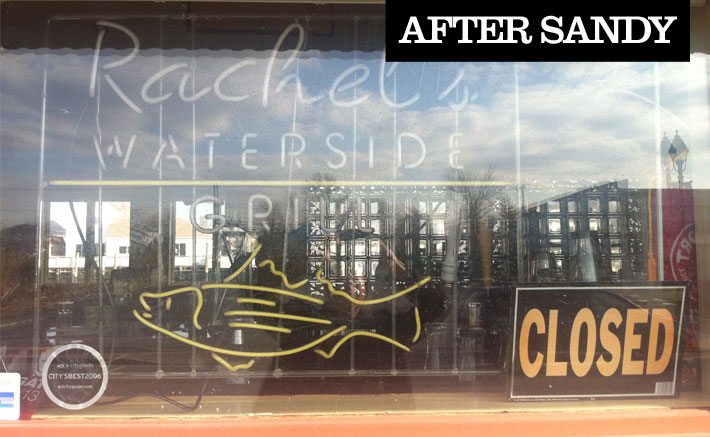
WASTELAND
Lindenhurst, too, was not an anomaly in the degree of ruin Hurricane Sandy rained down upon her and her residents.
The Frankenstorm, as it was called by meteorologists, since it took the freakish convergence of three separate weather systems to create such a mutant, pummeled villages and towns and cities all across the Northeast as it lurched from Florida up toward Pennsylvania, Vermont and eventually Canada, where it met its own slow demise.
New Jersey. Connecticut. The New York City subway system was force-fed hundreds of millions of gallons of the East River and Lower Manhattan was beneath several feet of seawater. The Long Island Rail Road was shuttered for days.
U.S. Sen. Charles Schumer compared parts of NYC in the days after the superstorm’s raid to what was left of London and Dresden after their firebombing during World War II.
Breezy Point, Queens looked like a hellscape after about 100 homes were lost in a mid-storm inferno. The ocean breached Fire Island twice and a third time at Westhampton’s Cupsogue County Park, which was nearly washed into Moriches Bay. Much of the dunes have been decimated on the barrier islands, giving a clear view of the Atlantic from Ocean Parkway. The Jones Beach theater was submerged and the boardwalk destroyed, same as in the City of Long Beach.
The latter was undoubtedly one of the hardest hit, if there is such a thing as varying degrees of complete devastation.
Hurricane Sandy took out its water service and sewage treatment plant—meaning by mid-storm, people could no longer flush their toilets or drink the water. The storm folded and dismantled its famous boardwalk like a shredded accordion, the beach now smothering much of Broadway, burying vehicles like a snowdrift. Residents complain of looters and the sound of gunshots at nighttime. The National Guard checks visitors’ IDs to ensure they actually live there before they’re granted access. It resembles a war zone.

The roof of a home decapitated by Hurricane Sandy sits among the wreckage that now defines Venetian Boulevard in Lindenhurst, a once-idyllic waterfront neighborhood on the South Shore. (Christopher Twarowski/Long Island Press)
Ditto for other sections of Western Nassau, such as Oceanside, Island Park, Atlantic Beach and the more than 550,000 residents and business owners serviced by Nassau’s historically troubled Bay Park Sewage Treatment Plant.
Whether the storm delivered the deathblow to the plant or it died due to myriad complications caused by its decades-long mismanagement, lack of maintenance and officials’ willful machinations—or a combination of all—the public may never truly know, though it doesn’t take an electrical engineer to understand that if you neglect even one critical process in such an multi-faceted facility for even a few days you compromise its entire stability, since each are interconnected and a means to the same end: treated sewage and wastewater.
At the least what Hurricane Sandy showed Nassau is that you can’t play politics with the public’s health and safety when your relying on aging, neglected and abused infrastructures.
Right now, more than 75 million gallons of barely treated sewage a day is being diverted into Rockaway Channel. People catch and eat fish out of these waters. The Press wonders if they’ve even been warned. If history’s a teacher, the answer is no.
Parts of Babylon were other casualties of Sandy’s.
Alexandra Pagano and Ken Byrnes only made it a few blocks south on Fire Island Avenue on Tuesday, Oct. 30, before they needed a boat.
Hurricane Sandy had moved the ocean just shy of Montauk Highway, about a dozen blocks north of Pagano’s parents’ house on Bayview Avenue.
She and her 2-year-old daughter heeded town officials’ mandatory evacuation orders the Sunday before the megastorm struck; her elderly father didn’t. Pagano said he was stuck on the second floor, and she and Byrnes were trying to get to him.
“I can’t get back,” she said, asking a Press reporter if the rowboat tied to a nearby tree was his. (It wasn’t.) “My house is going to be a disaster.”
Byrnes’ home was no better, maybe worse, he said—he lived in Long Beach.
“I lost everything,” he said, motioning with his hands just below his neck to show the height the water reached at his place. “Four feet.”
His father didn’t leave, either.
After several moments weighing their options, Pagano, 23, and Byrnes, 25, splashed their hiking boots into the shin-high water and trudged south, joining a steady stream of residents also returning home or seeking loved ones who stayed behind.
In his chest-high camouflage fly fishing waders, Kurt Verdillo instead headed north.
“It’s catastrophic down there,” he said.
The 51-year-old, who works at Great Bay Marine off the end of Fire Island Avenue and has lived in the neighborhood for 30 years, tells the Press he’d “never” seen flooding this bad before. He shared some photos he took to prove it.
“The boats are stacked up like Jenga,” he said. “One yard has 40, 50 boats that just floated and fell over.”
“The water level inside my shop was up to four-and-a-half feet,” he continued, as a man paddled a canoe near the corner of Sumpwams Avenue behind him. Another man towed a cooler atop an inflatable raft and turned down the block.
“Just trudge on,” said Verdillo, slopping through the water.
The Island is full of stories similar to Walker Pagano and Byrnes’—and as nearly everyone on Long Island and Eastern Queens knows all too well by now, residents didn’t have to live adjacent to the sea to be dramatically effected.







